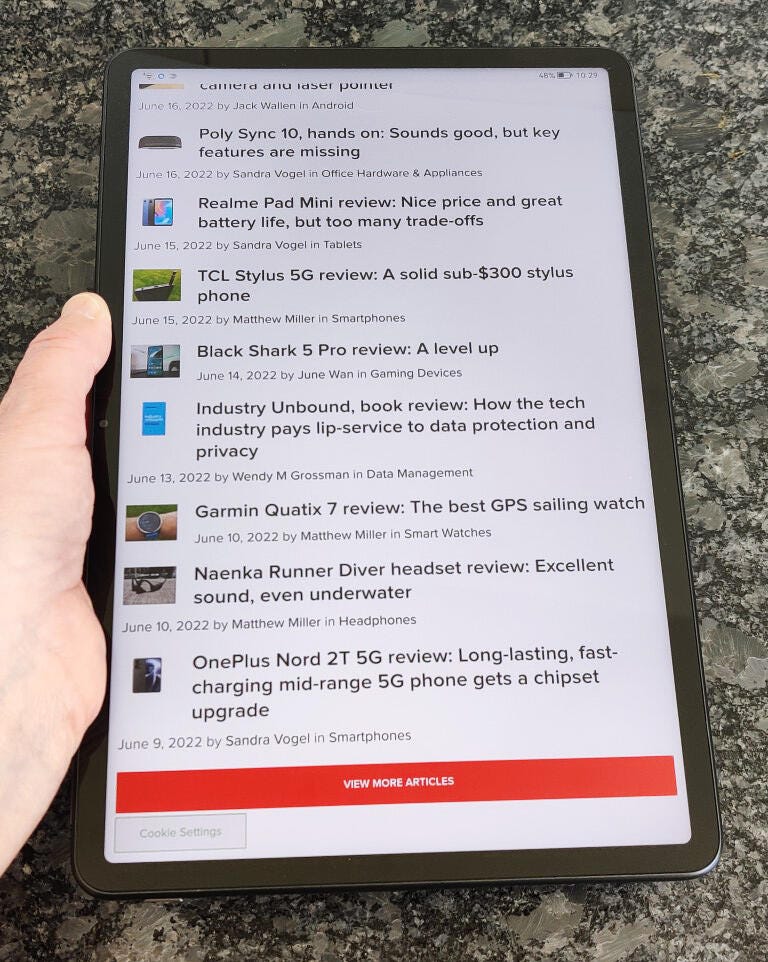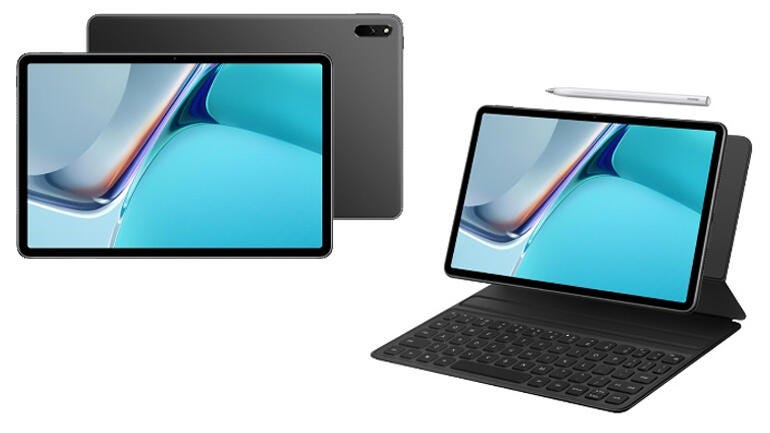The MatePad 11 runs Huawei’s HarmonyOS 2 system on Qualcomm’s Snapdragon 865 mobile platform, with 6/8 GB of RAM and 128/256 GB of internal storage (expandable by MicroSD card). Image: Sandra Vogel.
According to Canalys, 38.6 million tablets were sold in the first quarter of 2022, a number down 2.8% year-on-year. Apple takes first place, with a market share of 38.6%. Huawei, which takes fifth place in the first quarter of this year, has several tablets in its stable, including the MatePad 11. For just 400 euros, the latter comes with an external keyboard and an M-Pencil stylus.
Technical characteristics
- Dimensions: 253.8mm x 165.3mm x 7.25mm
- Weight : 485g
- Screen : 10.95-inch IPS LCD, 2560 x 1600 (275 ppi), 120 Hz refresh, 16.7 million colors, DCI-P3 color gamut
- Screen-to-body ratio: 86% (claimed)
- BONE : Harmony OS 2
- Processor : Qualcomm Snapdragon 865
- RAM: 6GB, 8GB
- Storage : 64GB, 128GB, 256GB
- microSD card: yes
- Rear camera: 13MP, f/1.8
- Front camera: 8MP, f/2.0
- Battery : 7250mAh
- Battery charge : 22.5W
- Wireless : WiFi 6 (802.11ax)
- Bluetooth: 5.1
- USB USB-C (USB 3.0, OTG)
- Location : GPS/GLONASS/BeiDou/GALILEO/QZSS
- Sensors: ambient light, compass, gravity, gyroscope, hall sensor
- Audio: 4 speakers
- 3.5mm audio jack: Nope
- In the box : tablet + battery, charger, Type-C cable, quick start guide, eject tool, warranty card
- Price : around 400 euro
A new ecosystem
The configuration of the MatePad 11 classifies it in the category of tablets which are not content to be an accessory near the computer, but which can be a full-fledged computer. Still, if you choose to replace your PC with the Huawei tablet, you’ll have to get used to HarmonyOS, an operating system and suite of services that Huawei developed after being kicked out of Google’s mobile services as part of a… conflict with the United States.
This is important, as it may mean shedding familiar ways of working and abandoning familiar applications in favor of other solutions. For example, if you have joined the Google ecosystem to work, you will need to access its services through a web interface rather than through native applications. There will be a learning curve for many users.
Still, HarmonyOS was designed to look and feel familiar, and it includes a lot of basics like a web browser, image gallery, map and route-planning app, calendar, a weather tool, as well as support for Gmail, Exchange, Outlook and other providers via manual configuration.
AppGallery is not the Google Play Store
App support is a weak point of HarmonyOS. Because the Google Play Store is absent, Huawei has developed its own Huawei store, AppGallery. This has apps in many categories, including business, education, shopping, sports and health, entertainment, and lifestyle. But the number of apps is not comparable to Google Play Store, and some popular apps are missing.
If you can’t find what you want in Huawei’s app store, you can try Petal Search, which searches the internet for installable files. For example, for my own purposes, Prime Video is not in the AppGallery, but I found it using Petal Search. Unfortunately, installs through this route do not support automatic updates, so users will have to perform manual checks.
All that noted, HarmonyOS looks familiar, both in terms of the overall screen layout and how the settings are organized and done. There’s a swipe-down control panel at the top right of the screen, and an accessible notification panel at the top left. Recent and pinned apps are in a bar at the bottom of the main home screen. Some apps come with “snippets”, better known to us as widgets, which can be placed on a home screen. For example, the Calendar application snippet summarizes the schedule for the day.
Design and screen
Huawei has done a good job with the build of the MatePad 11, which is available in Matte Grey, Isle Blue and Olive Green. It has a familiar rectangular shape, and measures 253.8mm wide, 165.3mm deep and 7.25mm thick and weighs 485g. It has small bezels around the screen and Huawei claims an 86% screen-to-body ratio, although our calculation puts the ration at 82.9%. Four loudspeakers broadcast good quality sound via two grilles located on either side of the screen (in landscape mode). The device supports MicroSD cards, which can be used to increase the internal storage capacity to 128 GB, of which 17 GB is used in the box.
The Qualcomm Snapdragon 865 chipset seemed pretty fast when I tested the MatePad 11, which had 6GB of RAM. There’s a 13 MP f/1.8 camera on the back and an 8 MP f/2.0 front camera for video calling. There’s nothing particularly special about the photography options, although the rear camera can shoot 4K video.

The IPS screen of the MatePad 11 displays a resolution of 2560 x 1600 (275 ppi) with a refresh rate of 120 Hz. The tablet weighs 485g. Image: Sandra Vogel.
The 10.95 inch IPS screen is superb. It’s crisp and bright with a resolution of 2560 x 1600 pixels (275ppi) and a refresh rate of 120Hz. Huawei has included a reading mode that pushes everything to grayscale, which is a big positive for me. . However, the screen is very reflective, which makes working a little tricky at times.
Good autonomy
Huawei claims the 7,250mAh battery lasts for 12 hours. In day-to-day use, it can actually, in my experience, handle a typical day’s workload of writing, browsing, and streaming, plus some after-hours music and video streaming. The downside is the 22.5W charging, which is quite slow.

The MatePad 11 6GB/128GB with keyboard and M-Pencil. Picture: Huawei.
Unfortunately, I couldn’t test the MatePad 11 with its dedicated keyboard because Huawei sent me a keyboard for another device. It’s a shame, because it means I couldn’t use the full 2-in-1 setup to write this article or do other writing tasks.
As for the tablet itself, the MatePad 11 is well made, with good battery life and decent speakers. The all-inclusive price for the tablet, keyboard and stylus is not excessive. The big downside could ultimately be HarmonyOS, which won’t be for everyone, especially when it comes to app support.
Alternatives
Huawei’s MatePad 11 tablet faces stiff competition, including similarly sized tablets from big names like Apple, Samsung and Nokia.
Apple iPad

Samsung Galaxy Tab S7+

Samsung Galaxy Tab S7+ – Best prices:
 Amazon Marketplace
Amazon Marketplace679.00
Shopping street
749.00
 Amazon
Amazon799.00
 Darty Marketplace
Darty Marketplace823.36
 Rakuten
Rakuten827.90
 Fnac marketplace
Fnac marketplace845.86
 Darty
Darty1029.99
 Fnac
Fnac1029.99
 Cdiscount Marketplace
Cdiscount Marketplace1034.58
Nokia T20
The Nokia T20 touchscreen tablet on Amazon
Source: ZDNet.com
